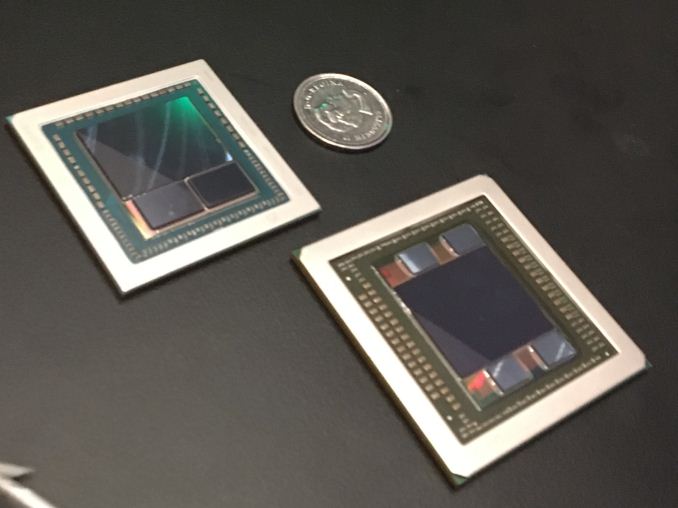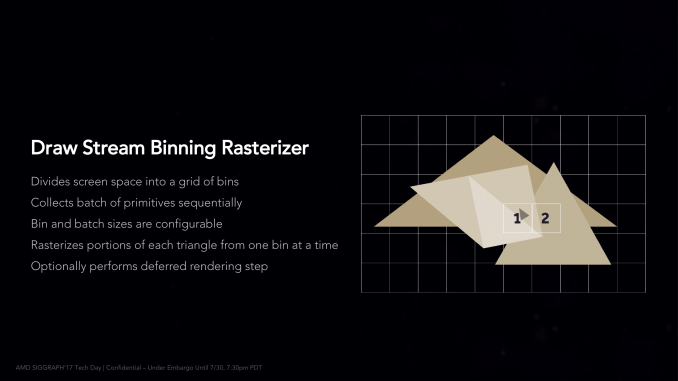Radeon RX Vega Unveiled: AMD Announces $499 RX Vega 64 & $399 RX Vega 56, Launching August 14th
by Ryan Smith on July 30, 2017 10:30 PM ESTFeatures & the Future Launch
Last but not least, along with today’s card announcements, AMD has also lifted the embargos on the architectural elements of the Vega 10 GPU. While there are no new architecture features to discuss – it turns out AMD was rather thorough with their preview at the start of this year – there’s still quite a bit in the way of details to dig into here. In fact it's more than I can hope to cover in a single day, let alone the few hours I’m getting to write this article ahead of AMD’s embargo. So I want to hit the highlights.
First and foremost, AMD has clarified that they do not consider Vega 10 to be a high performance computing (HPC) chip, unlike Hawaii. In particular, Vega 10’s native FP64 rate is just 1/16, like AMD’s other consumer chips. And the chip, while supporting HBM2’s native ECC mode, doesn’t have ECC on its internal pathways. This doesn’t mean that the chip can’t be placed in a server – its FP16 and INT16/INT8 performance is the cornerstone of its existence as part of the Radeon Instinct family. But that’s still a different market than traditional HPC. When we might see another HPC chip from AMD is anyone’s guess at this moment.
Second of all, we have a formal die size and transistor count for Vega 10. The GPU is officially 486mm2, containing 12.5B transistors therein. That amounts to 3.9B more transistors than Fiji – an especially apt comparison since Fiji is also a 64 CU/64 ROP card – all the while being 112mm2 smaller than Fiji (despite the higher transistor count) thanks to the higher density of GloFo’s 14nm LPP process, which AMD is using to fab the chip.
Talking to AMD’s engineers, what especially surprised me is where the bulk of those transistors went; the single largest consumer of the additional 3.9B transistors was spent on designing the chip to clock much higher than Fiji. Vega 10 can reach 1.7GHz, whereas Fiji couldn’t do much more than 1.05GHz. Additional transistors are needed to add pipeline stages at various points or build in latency hiding mechanisms, as electrons can only move so far on a single clock cycle; this is something we’ve seen in NVIDIA’s Pascal, not to mention countless CPU designs. Still, what it means is that those 3.9B transistors are serving a very important performance purpose: allowing AMD to clock the card high enough to see significant performance gains over Fiji.
Speaking of Fiji, there’s been some question over whether the already shipping Vega FE cards had AMD’s Draw Steam Binning Rasterizer enabled, which is one of the Vega architecture’s new features. The short answer is that no, the DSBR is not enabled in Vega FE’s current drivers. Whereas we have been told to expect it with the RX Vega launch. AMD is being careful not to make too many promises here – the performance and power impact of the DSBR vary wildly with the software used – but it means that the RX Vega will have a bit more going on than the Vega FE at launch.
Fifth, AMD is tweaking their boost clock mechanism and how it's advertised. Up until now, the boost clock was the maximum clock a Radeon card would hit. e.g. a stock Fury X topped out at 1.05GHz, and a stock RX 580 at 1340MHz. Starting with Vega RX, however, the company's definition of the boost clock is changing to the highest clockspeed a card is guaranteed to hit, but not the absolute highest clockspeed it can hit under load. There are still some nuances I want to test once I have the hardware in-hand, but at first glance this sounds closer to NVIDIA's definition, where each and every card is allowed to reach its natural limit (for the stock voltage).
Finally, while AMD didn’t clarify exactly when this change was made, the company has tweaked their Freesync Low Framerate Compensation technology to work with monitors that have a 2x range between min and max refresh rates, as opposed to 2.5x at launch. I’m told that 2.5x (or better) is still the ideal range, but it now works at 2x. This is an important development because the Samsung CF791 monitor that AMD is discounting as part of the Radeon Pack bundles has a 48Hz to 100Hz range; so it wouldn’t have been LFC capable under the old LFC rules.
Overall AMD has given us a lot to chew on – and more that can be covered in a single afternoon – but we still haven’t seen the whole picture. Today’s announcement of the card specifications and prices sets a very important baseline for what we should expect on August 14th, but no hard performance numbers to judge the final product. As I said at the start of this article, AMD’s marketing has done a very good job keeping Vega in the public’s mind. And today’s announcement is the next phase of that plan. But the end is approaching, and RX Vega’s full launch is drawing near, so it will be very interesting to see how everything we’ve learned over the last several months translates into gaming performance, power efficiency, and where AMD’s new place shall be in the realm of high-end video cards.













162 Comments
View All Comments
yhselp - Monday, July 31, 2017 - link
Wait, what? Trading blows with the 1080, and not the 1080 Ti? I thought flagship Vega was supposed to offer 1080 Ti+ performance for less money. I was also hoping the cut-down version for $400 would be very comparable to 1080 Ti, like R9 290 (non X) was to big Kepler. Not to mention cut-down HBM2, only 64 ROPs; the $400-500 4K dream looks more and more like a mirage.Am I missing something here? Weren't those cards supposed to be 12+ TF and 10+ TF - way more than 1080 and 1070?
haukionkannel - Monday, July 31, 2017 - link
In gpu same price gpu from amd and Nvidia has always been about the same speed.So now we have vega64 that is 500$ vs Nvidia 1080 about 500$ and They Are about the same speed. Is anyone surprised? No I did not think so. Vega will manage better in dx12 and Vulcan titles and Nvidia will beat Vegas in dx11 titles hands down... any surprices in there... no at all. This is very much what we did and can Expect.
When Volta will come out, it is more expensive than 1080 series if it is faster. If it is not faster it is about the same price (I predict that Volta is much faster in dx12 and Vulcan titles, but not so much in dx11.. it can even be slover in there compared to previous generation.)
All in all both companies have put the price quite close the Comparative product from the rival and it will continue Also in the future.
I am very happy about the Vega. The competition is back. Not Volta will have to compete against Vega and not against very old fury. And very soon after Volta comes out there will be Vega 2. The Navi is at least two years from now. If it is not, and Navi comes 2018, then Nvidia have some problems untill 2019 the will get out Volta2. But all in all the relative price vs. Competition will remain the same. regardless what is released.
yhselp - Monday, July 31, 2017 - link
Not necessarily true. When NVIDIA released Kepler (600-series), they decided to start charging double - $500 for a mid-sized GPU, instead of $250; and $1000 for the flagship in the face of Titan a bit later on. It was then that AMD shook up the market by releasing R9 290 - a $400 Titan alternative; at the time, the closest competitor NVIDIA had was 780 - a double cut-down big Kepler that was slower than R9 290 and cost $700. Obviously, all that was great for consumers, even those that weren't looking to buy AMD since NVIDIA cut the price of 780 and introduced 780 Ti.I was hoping for something similar with Vega.
Nagorak - Monday, July 31, 2017 - link
I think everyone was hoping for that. Unfortunately, something appears to have gone seriously wrong with Vega, hence the long delays.lordken - Tuesday, August 1, 2017 - link
Ah you say they have to price at same levels right? But AMD can undercut Intel by half with much better cpu, but cannot undercut NV??You talking out of your finger.
Most probable reason for that is expensive big die and HBM2
Nagorak - Monday, July 31, 2017 - link
No, you're not missing anything. The Vega architecture just sucks. It's a step back in every way from Fiji and Polaris.Tim Miller - Monday, July 31, 2017 - link
Does anyone remember the time when AMD released a card that was actually faster than the top NVIDIA card and didn't draw a lot more power? Or was it ATI?Dribble - Monday, July 31, 2017 - link
So how are those air coolers going to cool 300W? Would it not have been smarter to just release the water cooled card and let partners release the air cooled ones with custom monster 3 slot coolers? As it is all the Vega reviews will be with an air cooled Vega's, and everyone's memory of it will be "too hot, too loud, throttles hard". See 290 release for comparison.Nagorak - Monday, July 31, 2017 - link
It would have been smarter just not to release the gaming version at all, just said Vega gaming got cancelled and pushed the work station cards.vladx - Monday, July 31, 2017 - link
AMD most likely couldn't do that due to stockholder obligations.